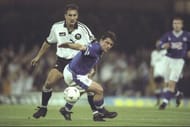English football clubs have produced a number of talented footballers from their academies who went on to perform well for their clubs. However, it’s a shame given their undoubted talent on the domestic circuit that they didn’t really fit into the England national team.
With the football World Cup on the horizon and the England national team just 5 months away from picking their 23 men squad, we take a look at 5 players who were sensational for their clubs but somehow never quite made the cut for the three lions.
All the players in the list were once hailed as England’s next big thing but never made it on the big stage.
There are a few other examples of young English players, most notably Manchester City’s Paul Lake who showed immense potential after leading City out of the Second Division when he was just 21.
He was hailed by some as a successor to Bryan Robson as an all-action midfielder. Lake tore his anterior cruciate ligament (sounds painful), played 4 games in 6 years and Robson was succeeded by Carlton Palmer, something we should all mourn.
#5 Andy Cole
One of the best strikers of the Premier League era, some argue that Cole’s goal-scoring stats can rival anyone's but then there are those of us who watched him play.
For all the jokes levelled at Cole, his scoring record for Newcastle was phenomenal; 55 goals in 70 games! Cole’s club form earned him a call-up from Terry Venables but he drew a blank and didn’t make the cut for Euro ’96.
But by that time, Cole had moved to Manchester United where despite playing alongside Cantona, Giggs & Beckham, he mustered 17 goals each in his first 2 full seasons.
Eventually, Cole rallied to score 93 goals in his Manchester United career, but some of his misses were hugely disappointing, with the most notable among his dismal showings being his barn door performance at West Ham that ultimately cost his side the 1995 League title.
His England career was acutely summed up by Glenn Hoddle who claimed he needed “6 or 7 chances to score.” Predictably, he never found the net for Hoddle or Kevin Keegan (for whom he’d performed so well at Newcastle) and he missed out on the ’98 World Cup and Euro 2000.
Sven-Goran Eriksson offered Cole a fresh chance but he bottled that as well. Cole started in Eriksson’s early World Cup qualifiers and actually scored (but it was only against Albania). By the time qualification was secured, Cole had dropped down the pecking order.
Finally, Eriksson omitted Cole from his World Cup squad and laughably, within an hour of the announcement, Cole declared he was retiring from International football. Andy’s record of 1 goal from 15 caps really says everything. But he’s still got an enviable medal collection.
#4 Lee Bowyer

Bowyer emerged in the late ’90s as a dominant midfielder with the work rate and skill to rival Steven Gerrard. He scored an impressive 6 goals from midfield in Leeds’ unlikely run the Champions League semi-finals as David O’Leary’s young side turned heads around Europe.
At the time, England had a settled first choice midfield with Beckham, Gerrard & Scholes but behind them, options were thin on the ground (even Kieron Dyer was called up!) Yet Bowyer remained absent.
The reason for Bowyer’s exclusion was a controversial court case where Bowyer and teammate Jonathan Woodgate stood trial for grievous bodily harm. Remarkably, Bowyer played whilst the trial was ongoing and produced some of his best football.
Bowyer was cleared of the charges but his reputation was already stained (not helped by previous incidents in Leeds & London). Whilst the case was ongoing (and it lasted almost 2 years), the FA barred Bowyer from England selection and after the trial, he was finally called up.
He was picked to play a friendly against Portugal and when he provided the cross for Leeds teammate Alan Smith to score, it seemed Bowyer had finally arrived for England.
Unfortunately, it turned out he was finishing off with them as in the aftermath of the trial, Bowyer fell out with Leeds over a fine and was soon shipped out to West Ham and eventually settled with Newcastle. But Bowyer couldn’t rekindle the form that made him one of the best midfielders in the country and his career sank into mediocrity.
One way or the other, it would seem like that infamous night out in Leeds cost Bowyer an England career.
#3 Tony Cottee

Tony Cottee was hailed as England’s next big thing after emerging from West Ham’s famed academy in the mid-’80s. The problem for Cottee was that his game was very similar to England’s then big thing; Gary Lineker.
In 1986, aged 21, Cottee was named PFA young player of the year following a prolific season at West Ham, bagging 20 goals for the Hammers as they reached the giddy heights of 3rd place in Division 1.
In the same year, Lineker scored 30 for Everton who finished 2nd and reached the cup final. Lineker went to the World Cup won the Golden Boot and signed for Barcelona.
At the start of the following season, Cottee made his England debut as a sub and he managed 22 goals for West Ham thanks to a deadly partnership that he formed with Frank McAvennie. But with Lineker almost never injured or out of form, more England chances were coming at a premium.
Two years on, Cottee finally left West Ham for Lineker’s old gig at Goodison Park- surely his chance at the bigtime. Unfortunately, he joined Everton a year too late and the Howard Kendall glory era was starting to fade.
Cottee did score a respectable 72 goals in 6 seasons at Merseyside, but it wasn’t quite the prolific showings he needed. Cotten finally made his first England start in 1989 against Scotland at Hampden Park, but he didn’t find the back of the net.
Unfortunately for him, England debutant Steve Bull did score that day and got the final forward’s spot in the ’90 World Cup squad.
Cottee never played for England again although he did play on in the Premier League all the way until 2001 (aged 36) before dropping down the divisions and retiring. His last 3 Premier League seasons were spent at Leicester City with Walkers Crisps emblazoned on his jersey. The irony.
#2 Michael Bridges

Some folks reading this would say, "Michael who?"
Bridges is on this list for what he promised to be rather than what he achieved. After emerging in 1998, at the then high flying Sunderland, Bridges proved that he had the vision to play as a number 10 along with the pace and finishing skills to be a number 9 which resulted in people drawing early comparisons to Dennis Bergkamp.
His talent didn’t go unnoticed and aged just 21, he was signed by David O’Leary’s Leeds for £5 million. O'Leary claimed Bridges was a long-term project but after selling Jimmy Floyd Hasselbaink that summer, Bridges was in the first team and immediately bagged a hat-trick.
He finished his first season with 21 goals as Leeds made an unlikely title challenge and made it to the UEFA cup semi-final.
An England call-up was expected next season (many of his young teammates were full internationals by then) but then disaster struck. Bridges was stretchered off in a Champions League group game in October and didn’t play again that season. An endless cycle of injury and rehabilitation began and he made only 10 appearances over the next 4 years.
After that, Bridges began to drop down the divisions even faster than Leeds and was last seen playing at the beautifully named Lambton Jaffas in his native North East. For the England under 21s, he played 11 times (all in those 2 seasons at Sunderland & Leeds) netting 3 times.
Injury has wrecked many a career but very few have been dismantled in such frustrating circumstances as Bridges, who showed so much promise in such a brief period.
#1 Dave Beasant

Beasant’s career was real Roy of the Rovers stuff. After starting his career at Edgware Town, he moved to 4th division Wimbledon in 1979. He would stay for the whole Crazy Gang ride from the bottom of the football pyramid to the first division to finally become FA Cup winners.
And it was Beasant who Wimbledon had to thank- making history by saving a penalty from John Aldridge as they ran out 1-0 winners at Wembley.
Beasant developed a reputation as a great penalty stopper and was consistently amongst the top ‘keepers in the first division during the late ’80s.
Eventually, England came calling and in 1989, Beasant, aged 30, made his debut against Yugoslavia. He was initially left out of the Italia ’90 squad but an injury to David Seaman meant he got in as the number 3 ‘keeper.
Beasant spent the entire tournament (even the 3rd place playoff game) on the bench. After the tournament, he never represented England again.
Also read: 5 successful international players who underperformed in club football
